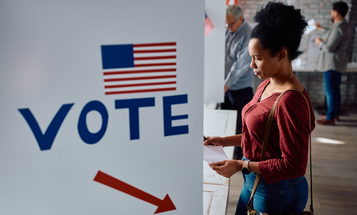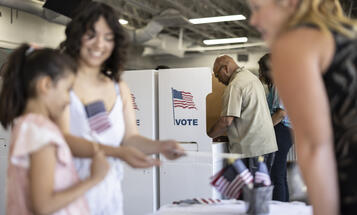
A U.S. District Court Just Blocked Same-Day Registration in Illinois
Yesterday, U.S. District Court Judge Samuel Der‑Teghiayan blocked Same-Day Registration (SDR) at all precinct‑level polling locations in Illinois for the November 8 Presidential Election.
The ruling eliminates a policy that has operated in the Prairie State since a pilot bill initially passed in 2014, followed by passage of permanent implementation in 2015. Pending a successful appeal by the Illinois Attorney General’s office—who have directly stated that they will do so—the reform will only be offered at a limited number of locations during this election. This will reduce the number of states that currently offer or are due to implement SDR to fifteen (which includes North Carolina, where this past August the U.S. 4th Circuit Court of Appeals unanimously overturned North Carolina’s discriminatory voting restrictions that passed in 2013); the District of Columbia also offers the reform.
Within Illinois, this ruling reverses election preparations that are already underway, in a state where an estimated 110,000 residents took advantage of the reform during March primary.
The main argument from the plaintiffs who brought this case forward is that SDR disadvantages voters who live in counties that contain less than 100,000 residents and/or do not possess electronic polling books at their respective voting locations. Before the ruling, these voters did not have access to SDR within their local, individual polling locations; instead, using SDR required that they traveled to a centralized location within their respective voting jurisdictions. Evidenced in large measure by higher voter turnout increases within the requisitely populous and electronic pollbook‑equipped areas, the plaintiffs concluded that rural voters faced a disproportionate burden and thus operated at an electoral disadvantage, as matters of equal protection and political representation.
Conversely, the defendants argue that following successful usage during the primary, such a change so late in the election season places an undue burden on election officials to provide adequate access and information to voters. As successful as the pilot program was in 2014, the limited number of SDR locations at the time led to long lines, frustration at the polls and delays in receiving official election results; hence the larger and more permanent expansion.
Judge Der‑Teghiayan states the following in his opinion:
In the instant action, the Plaintiffs have provided ample evidence showing that the availability of polling place registration as part of the EDR results in a significant increase in voter turnout. That in turn shows that in a low‑population county without electronic polling books there will be a significant disadvantage under the EDR as it stands in Illinois. The EDR would severely burden their right to vote. Defendants argue that the availability of polling place registration is merely an inconvenience because EDR will still be available in all counties in certain location other than polling places… The polling place registration option is applied in an arbitrary and disparate fashion among low‑population counties in Illinois and is not the type of “[o]rdinary and widespread” burden that was considered not to be severe… While it may be true that the polling place registration option can assist voter in certain populous counties, that option cannot be provided at the expense of lower population counties, thereby decreasing their political representation in Illinois. The application of this legislation favors the urban citizen and dilutes the vote of the rural citizen…While it is a desirable goal to make the voting process more readily available to United States citizens in Illinois and to encourage them to vote, that goal must apply equally to all United States citizens in Illinois.
Ironically enough, yesterday was also National Voter Registration Day, which by definition aims to increase the numbers of eligible voters who haven’t been formally brought into the process. As a failsafe measure, SDR is so effective because it guarantees the ability for individuals to still have access to the ballot, as close to or on Election Day as possible.
In the November 2014 Midterm Elections, voter turnout in Same‑Day Registration states was over 11 percentage points higher than in non-SDR states, including nearly 6 percentage points higher than NC. In a cycle of depressed turnout across the country, five SDR states yielded record‑high Midterm turnout (Colorado, Connecticut, Iowa, Montana and Wisconsin). In 2012 (the last election where NC offered SDR), four of the top five states for voter turnout in the 2012 presidential election all offered Same-Day Registration, and average voter turnout overall was over 10 percentage points higher in SDR states.
Hopefully, a quick appeals ruling will restore SDR in Illinois to its original form.



